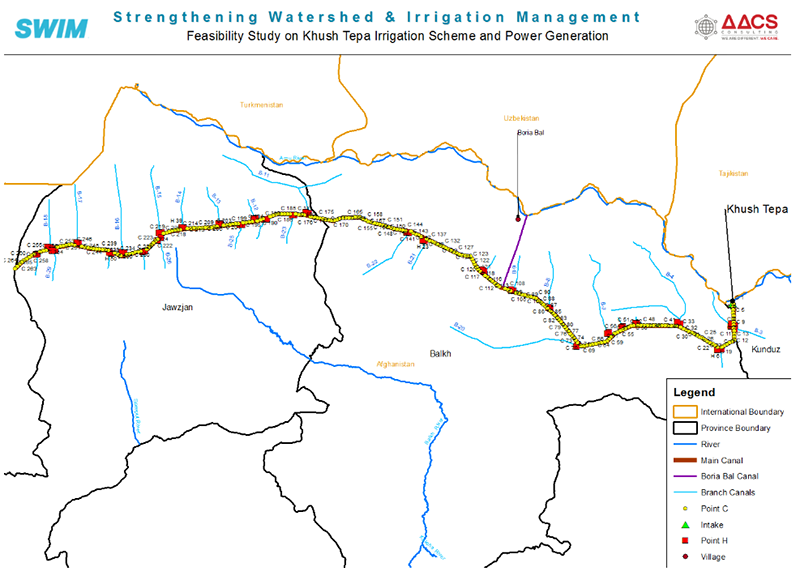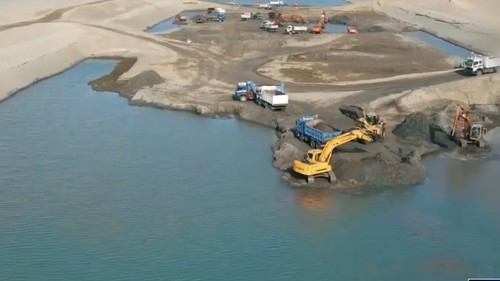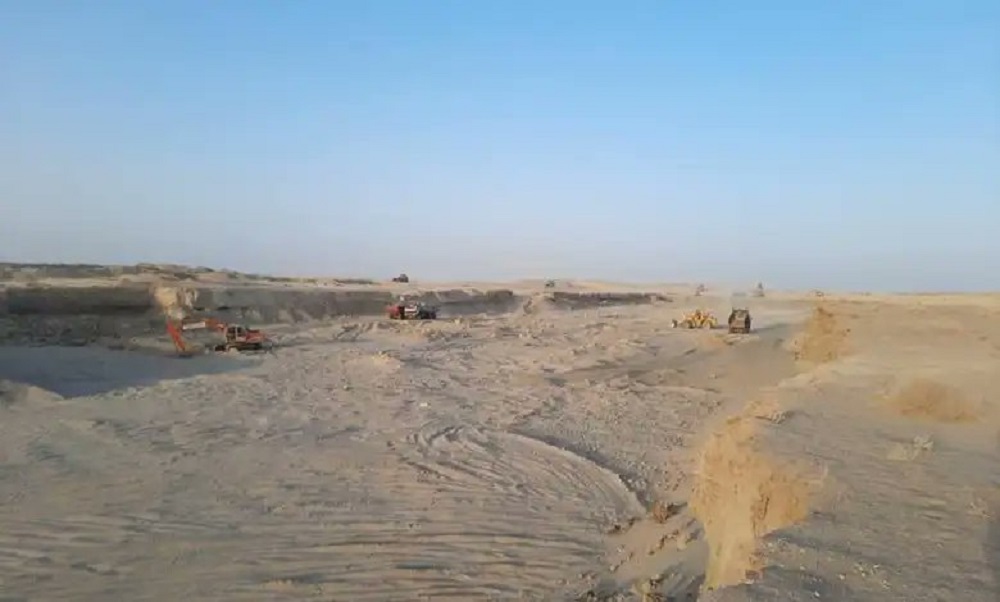
Section 12. Thematic reviews
12.5. Construction of the Qosh-Tepa Canal in northern Afghanistan (March 2022 – March 2023)
On 10 December 2018, a feasibility study for the Qosh-Tepa Irrigation Scheme and Power Generation was launched at the Office of the President in Kabul, Afghanistan. The feasibility study was completed in 2018-2019 by AACS Consulting and BETS Consulting Services Ltd as part of the USAID Strengthening Watershed and Irrigation Management (SWIM) project implemented by AECOM International Development, Inc./DT Global. The request for expression of interest was announced by AECOM on 20 March 2018. The feasibility study worth of $3.6 million was conducted in coordination with the Ministry of Agriculture, Irrigation and Livestock, Ministry of Energy and Water, and National Environmental Protection Agency of Afghanistan. The feasibility study has not been published finally.
The construction of the Qosh-Tepa irrigation canal was inaugurated on 30 March 2022. The canal will originate on the left bank of the Amu Darya in Balkh province. The canal will pass from Kaldar through Dawlat Abad (Balkh), Faizabad, Aqcha (Jowzjan) to And-Khoy (Faryab) for irrigation of land in these provinces.
General information. The total length of the Qosh-Tepa canal will be 290.5 km, with the width of 100 m and the depth of 8.5 m. The main canal is 208.307 km and the two branches are 37.369 km and 44.909 long, respectively. The system will include 27 secondary canals stretching to 502 km in total.
The total command area of the canal is 550,000 ha, and the gross irrigated area is 331,500 ha, while irrigable area is 276,500 ha in Balk, Jowzjan, and Faryab provinces. About 230.3 thousand ha of land is planned to be irrigated by gravity and 46.2 thousand ha by lift irrigation. In general, up to 6 billion m3 of Amu Darya flow will be abstracted annually to meet the project’s irrigation demand.

Source: SIC ICWC, March 2023
Implementation. The project is to be implemented in 6 years in three phases. The first phase is 108 km, which is expected to be completed by June 2023. The second and third phases, which combined make up 177 km, are expected to be completed within five years by 2028.
The project is implemented by the national development company of Afghanistan. The Melli company under the Ministry of Finance have got a contract for construction from the former government. On 22 February 2023, it was announced that a joint committee would be formed of the Administrative Office of the Islamic Emirate, Ministry of Agriculture, Irrigation and Livestock, and National Development Company for further coordination of activities on the Qosh-Tepa Canal.
Financing. The total project cost will depend on the design chosen and may vary from $676 million to $1.951 billion. The financing was stated to get funding from national budget. According to the Ministry of Finance (MoF), the government allocated 7 billion Afs (approx. $79 million) for the Qosh-Tepa canal in 2022 budget.

Source: AACS Consulting request for proposal for “Geotechnical Site Investigation”
RFP No.: AACS-KTISPGFS/2019-0002. March 13, 2019
Pace of construction since March 2022 till March 2023 45 km of the Qosh Tepa canal have been completed by November 2022 and over 100 km by March 2023. A water filled section of the canal stretched to 33.3 km in March 2023.
By 20 November 2022, up to 4,000 people were engaged and 2.6 thousand pieces of heavy equipment were used in the construction. Local authorities stated that construction work was speeded up at the end of 2022 and, thus, the project was expected to be completed ahead of its due date. As of January 2023, the construction work was underway in 120 locations and nearly 6,000 people were working in the project. The first phase of 108 km long is to be completed in the next six months (June 2023).
The National Development Corporation said on 2 January 2023 that it will change the route of the Qosh Tepa Canal in northern Balkh province in order to protect historical structures situated between Kaldar and Dawlat Abad districts. Changing the canal’s route will cost an additional 3 million Afghanis.
Dialogue with riparian countries. The canal will divert water from the Amu Darya River shared by Afghanistan, Kyrgyzstan, Tajikistan, Turkmenistan, and Uzbekistan. The above feasibility study didn’t seem to make an assessment of the potential impacts of planned activities on the riparian countries. No official notifications have been sent to neighboring countries prior to the start of the project.
In December 2022, President of Uzbekistan, Shavkat Mirziyoyev considered it necessary to initiate a dialogue on joint construction of the new canal in the Amu Darya Basin together with the interim government of Afghanistan and the international community in line with international norms and with account of the interests of all countries in the region.
The Deputy Prime Minister for Economic Affairs, Mullah Abdul Ghani Baradar Akhund in his Twitter account wrote on 22 March 2023 that Uzbekistan had expressed readiness to work together with Afghanistan’s technical teams to improve the efficiency of the Qosh Tepa Canal project along with other infrastructure projects. The Afghanistan’s right to water in the Amu Darya River under international law and with full account of country’s privileges and rights was noted. He assured that the completion of the Qosh-Tepa Project would enhance bilateral relations between the two neighboring countries.
Norms of international law. No general water cooperation agreement exists for the Amu Darya riparian countries. The water use relations between the CA countries are governed by the Agreement on Cooperation in the Field of Joint Management of the Use and Conservation of Water Resources in Interstate Sources (1992 Almaty Agreement) that retained the water allocation quotas in the Amu Darya Basin for Kyrgyzstan, Tajikistan, Turkmenistan and Uzbekistan set in 1987. The presumed water diversion by Afghanistan of 2.1 km3/year was deducted in the allocations from available usable water resources.
Agreements between the CA countries (as legal successors of USSR regarding boundary areas) and Afghanistan do not cover the issue of water sharing of the Amu Darya but establish the general order of frontier water use. The 1958 Treaty concerning the regime of the Soviet-Afghan state frontier sets that: (1) in the use of frontier waters, and of the waters of rivers which flow to the frontier or into frontier waters, the mutual rights and interest of both Contracting Parties shall be respected (Article 7); (2) matters concerning the use of waters shall be governed by special agreements (Article 16); (3) the diversion of water and other matters associated with the use of frontier waters shall be agreed on (Article 18); (4) any constructions likely to influence the flow of water or cause damage thereto shall not be erected except by agreement between the two Parties (Article 19).
Afghanistan is not a party of the UN Convention on the law of non-navigational uses of international watercourses (New York, 1997) and the UNECE Convention on the protection and use of transboundary watercourses and international lakes (Helsinki, 1992) that contain the most comprehensive list of rights and obligations as concerns transboundary water. Meanwhile, many provisions of the global water conventions are the norms of customary international law that all states are bound to adhere to. These include: (1) utilization of a watercourse in an equitable and reasonable manner; (2) taking all appropriate measures to prevent, control and reduce transboundary impact; (3) provision of minimum river flow for environment; (4) cooperation with riparian states in good faith in order to attain optimal utilization and adequate protection of an international watercourse. Minimum procedural obligations that are recognized as customary law are: (1) regular data and information exchange with riparian countries; (2) consultation with each other on transboundary water; (3) prior notification regarding planned activities; (4) transboundary environmental impact assessment.

